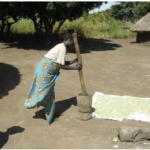


Kenya Agricultural and Livestock Research Organization
C-MAD, KOMHEC, CARD, GAPP, CREPP, KEPHIS, KACE, KIRDI, ARARI
Uganda, Kenya, and Ethiopia
11/2014—11/2017
Finger millet is an important crop in Kenya, Ethiopia and Uganda. Its nutritive properties, wide adaptability, tolerance to adverse weather effects, and excellent storability make it ideal for food security and poverty alleviation. Finger millet yields in the region are generally low due to the following constraints: labor intensity, low soil fertility, low yielding varieties, unreliable weather, high input prices, and disease. The aim of the present study is to engage non-governmental and community-based organizations with farmer networks in new project areas to help scale benefits gained from the previous project phases and to contribute to sustainable increased finger millet productivity and production, food and nutrition security, and improved livelihoods. The project will enable the research team to interact more collaboratively with farmers and grassroots development organizations to test additional soil fertility and crop management strategies, as well as, to determine how different finger millet production options are suited to varied socio-ecological contexts. The team will focus on developing more farmer-participatory and agroecologically-oriented production strategies such as: integrating finger millet with legumes for soil and pest management benefits and micro-dosing using organic and inorganic fertilizer mixtures. Throughout the project, the team will engage with farmers’ knowledge, capabilities, and perceptions of the technologies to inform their work. The team will also focus on contextualized scaling using the farmer research network approach.
Despite its superior tolerance to abiotic stress and superior nutritional and storage characteristics, FM acreage has been on the decline in the region. This project team believes that FM can make important contributions to system performance and is committed to reversing the declining trend using a variety of strategies. Previously, the project used a fairly straight up technology transfer approach, featuring new varieties, fertilizer use, line planting for weed control, equipment for mechanization and new crop utilization strategies/products. The fruits of their efforts were visible enough that the Kenyan PI won the best project prize from the Kenya Agricultural Research Institute. This proposed phase sees the team focusing on developing more farmer-participatory and agroecologically-oriented production strategies, such as integrating FM with legumes for soil and pest management benefits, micro-dosing using organic and inorganic fertilizer mixtures, while taking farmers’ knowledge, capabilities and perceptions of the technologies into account, more closely aligned with the AEI focus of CCRP.
Outputs
Outcomes
